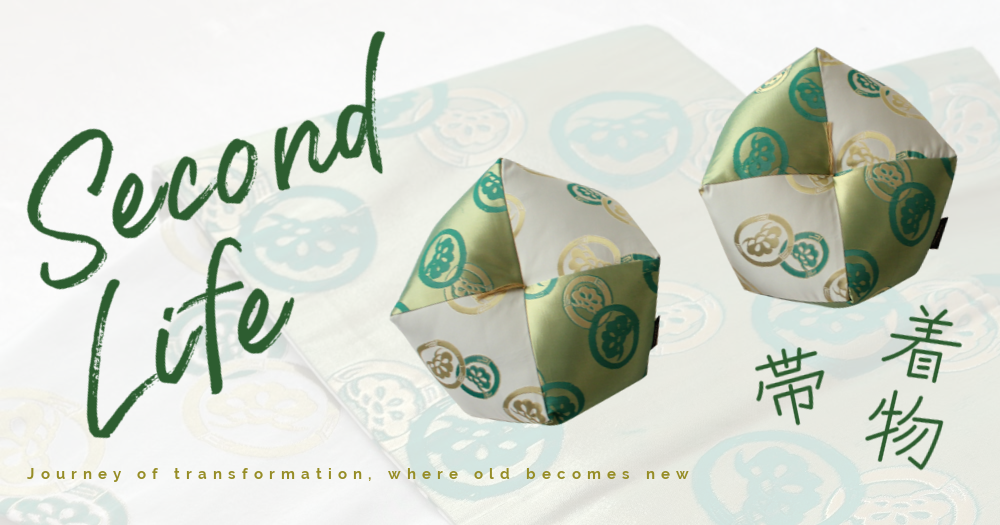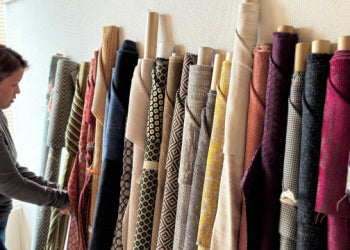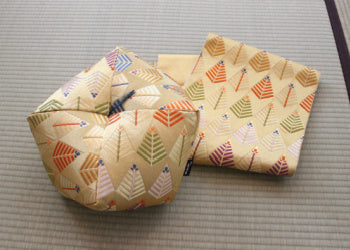
The idea of transforming vintage, pre-loved garments into contemporary home décor is extremely meaningful because not only does it offer a fresh take on both fashion and interior aesthetics, it also breathes new life into something old to spark new joy.
In this blog post, join us in exploring the journey from traditional Japanese obi belts to stylish Ojami cushions, blending cultural heritage and modern design. Please enjoy the showcase of the beauty of the original vintage Obi belts and their transformed state of comfortable Kangu from our first Second Life Collection.
The Charm of Vintage Obi Belt

Obi belts are traditional Japanese sashes that are worn with kimonos for centuries. Characterized by their rich fabrics, intricate embroidery, complex woving techniques, and vibrant colors, these belts are a testament to Japanese craftsmanship and cultural heritage. Each obi belt tells its own story, often reflecting historical patterns and motifs unique to different eras and regions.
The Transformation Process
Transforming an obi belt into an Ojami cushion involves several meticulous steps:
1. Deconstruction and Preparation: The cutting craftswomen need to study the flow of the patterns displayed on the Obi Belt, and decide how to dismantle the belt and cut the fabric to preserve as much of the original design as possible. This step ensures that the final product retains the essence of the vintage piece.
2. Assembly and Stuffing: When sewing the the different panels of the cut Obi belt, the craftswoman has to be careful in ensuring the the patterns and motifs are aligned so that once the cushion is filled with cotton stuffing, the Ojami cushion’s appearance reflects the beauty of the original belt.
3. Finishing Touches: When sealing up the Ojami cushion with the invisible stitch, the craftswoman once again had to make sure that the patterns and motifs are aligned. Once the Ojami cushion is stitched close, the craftswoman will have to decide on what color silk thread to use for the tassels, so that it compliments the obi belt.
These are the finished Ojami cushions made from the first Second Life series:

Obi Belt 1
This is a reversible Obi belt filled with pine tree emblems. Known as "matsu", pine trees are iconic symbols that represent endurance, longevity, festivity and celebration, and eternal youth.
The Ojami Cushions can be made three ways. The first is make an Ojami using the entire light green side; the second is to use the entire silver side; and lastly, to combine the light green and silver in alternating panels.
The customer chose to combine the different colors to make 2 Ojami Cushions and picked a matching gold silk thread for the tassels.

Obi Belt 2
The second obi belt featured a buddhist design made up of intricate floral motifs, known as housouge (宝相華文). It is created from an array of flowers, to symbolize elegance and spirituality.
The customer chose to use the front of the obi belt to make her Ojami cushion instead of combining the front and back of the obi, for a more dramatic-looking Ojami Cushion.

Obi Belt 3
From far, the third obi belt looks like a plain white obi belt with golden embroidery of floral motifs. Up close, you can however see that the white fabric is filled with beautiful woven patterns, known as "jimon"(地紋), for texture and aesthetics. The embroidery featured on the obi belt are Spring flowers seen commonly in Japan.
We used the front of the Obi belt to create an Ojami Cushion that displayed the intricate embroidered floral motifs on alternative panels.

Obi Belt 4
What makes this piece of obi belt outstanding is the creative display of the Shippo design, which traditionally is an unending chain of interconnected circles. On this obi belt, a new pattern is formed with the connected circles, adorned with flowers.
Shippo means "seven treasures", and is a reference to the seven treasures of Buddhism, made up of gold, silver, lapis lazuli, crystal, mantis shrimp, coral, and agate, representing 7 core values. The Shippo design signifies harmony, prosperity, and good fortune.
We used the full front panel of the Obi belt to create this Ojami Cushion.
Recreating Beauty through Reimagining Tradition
The transformation from vintage obi belts to Ojami cushions is not just a celebration of cultural heritage and artistic innovation, it also embodies the "Mottainai" spirit, where we breathe new life into something old but still good for other uses.
We hope that by catching a glimpse into the transformation of vintage obi belts into Ojami cushions, will inspire you to on new ways to introduce a touch of elegance and heritage richness into your home décor.
Introducing A Brand New Collection - Second Life Series 2
We have opened up our Kiribako box, to take out 5 more exquisite pieces of Obi belts, reflecting different styles and moods. If you love to own an exclusive, prized piece of comfort and Japanese artistry, check out the new Second Life Series 2 collection now! Each obi belt is one-of-a-kind and once sold, it will be almost impossible to get another obi belt in the same design.
Want to see more of the Second Life Series 1 collection? Check it out here.



